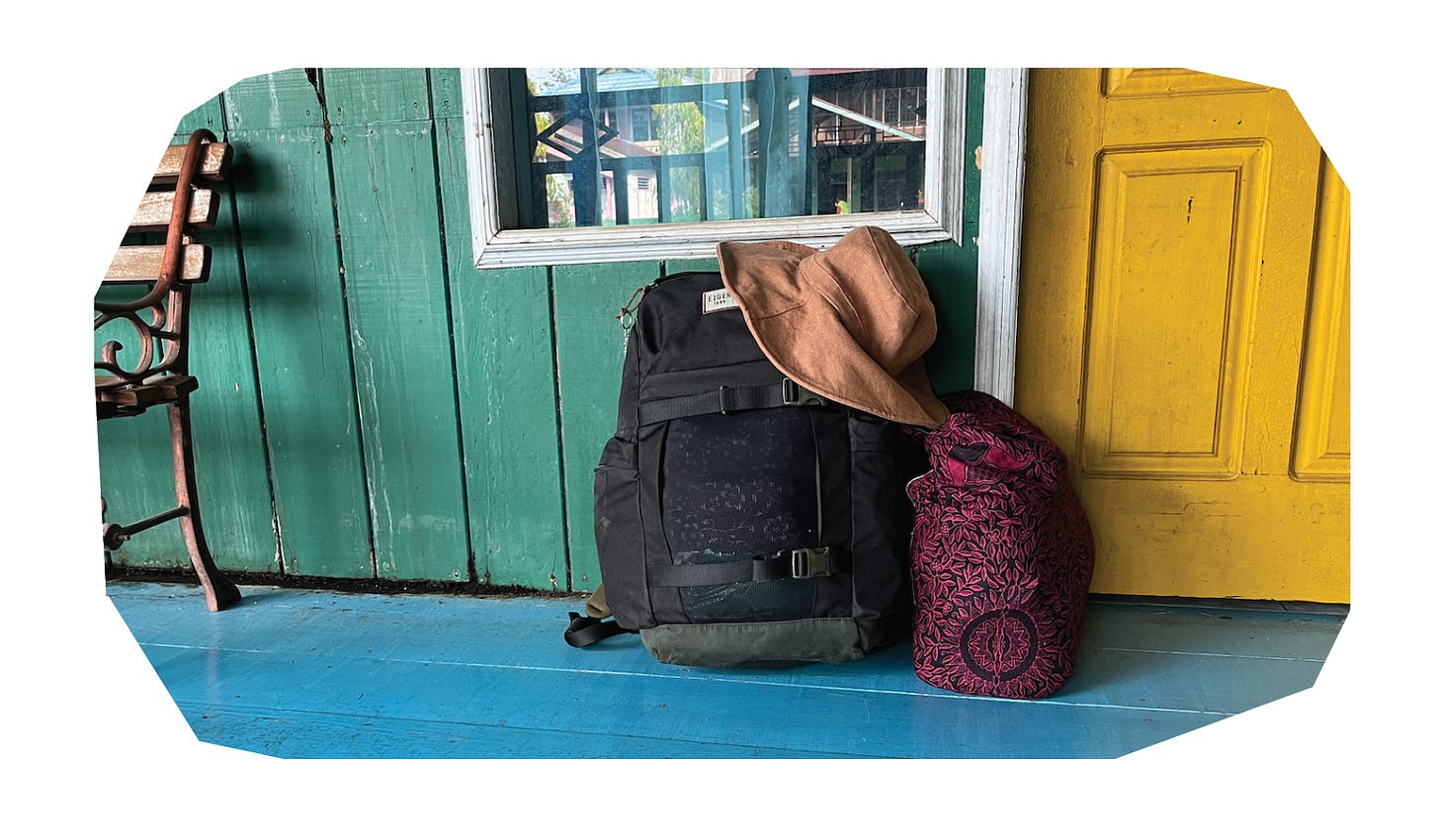I’ve committed to establishing NE Where as an independent space for travel writing, and your interaction will really help me to do so :) If you enjoy this post please “like” it by clicking on the heart at the top or bottom of this page, drop a comment or consider sharing this post with friends, or if you haven’t already, subscribe to NE Where – which you can do for free, or as a supporting member for $5 a month .
Me, road tripping through Sumatra back in 2015 – and not travelling very light.
Dear NE-One
Is there something – one thing – that people often assume about you, but that they get spectacularly wrong?
For the longest time, people have assumed that I’m “good at packing”. What they’ve implied has varied – usually that I’m able to pack light, or neatly, or without much stress – but the truth is, for more than a decade I’ve been monumentally bad at packing. I’ve lugged a bulky kitbag around the world and mumbled excuses about travelling with books and computer and camera gear, as well as having to carry clothes suitable for stays everywhere from remote jungle camps to ultra-chic city hotels.
Looking for stories and tips from my Bali series? You’ll find them here.
Last year, though, I stumbled across something that’s been a game-changer for me: compression packing cubes. And because of these nifty little bags I’ve gone from being one of those people who hauls themselves awkwardly onto a bus with a too-large bag in tow (Excuse me… ’scuse me. Sorry. I’m sorry. Can I just squeeze past? Oops! Sorry. Excuse me, sorry), to someone who simply hops effortlessly from boat to train to bus with one small daypack and a camera bag slung over her shoulders.
Really, it’s true. This below is what I carried back in December when I travelled two weeks through Borneo, as well as on an island-hopping road trip around Bali through February. It’s also what I plan to take next weekend when I set off on a month-long trip through Madagascar:
In the black bag, for the record: my clothes, computer, a pair of running shoes, a sarong and toiletry bag. In the other: my camera and two lenses, a notebook, reading book and another sarong.
I’ve monologued about the merits of compression packing cubes so many times that whenever I mention them Mark rolls his eyes (and he swears by rolling his clothes, btw) – but these nifty cubes really are a brilliant way to save on space. How they work is simple: once your clothes are packed inside, you close the zip that wraps around the cube and – voila! – the bag is (kind of) a fraction of its former size:
There are seven men’s T-shirts in this bag, just FYI.
I bought my compression packing cubes off Amazon last July – these ones, right here. They came in a set of three, and I was so taken by them that I bought a second set. I have no idea how many times they’ve been zipped and unzipped in the past nine months – from early November until today I’ve shifted accommodation 48 times (that’s an average of once every 3.4 days). I’ve used these lightweight cubes consistently and they still look good as new: stitching’s all intact, fabric’s strong and the zips remain sturdy.
Next weekend, I’m hitting the road again. Coming up is a trip through the highlands of Madagascar, which Mark and I will do by public transport. There will be a fair amount of walking too – between villages and around national parks – and so even though just yesterday we settled back into our South African home, packing (light) is on my mind again. I’ll be sharing some of the Madagascar journey on Instagram stories, so if you’d like to follow along please connect with me here.
I’ll be on a plane next week Sunday but NE Where will be landing in your inbox, as per usual. I caught up recently with someone who biked her way across Turkey, Georgia, Armenia and Iran – and I can’t wait to share her story!
Until then,
Narina x
PS What’s your best packing hack? I’d love to know!
Mark’s first Indonesia travel book, Kopi Dulu, was published by Penguin last year and his first novel, Driftwood Chandeliers (a haunting tale of life and death on the other side of Bali), was released yesterday. It’s currently available in hardback, and I’ll drop you a line once the e-book and paperback are released.
In a reading kinda mood? Put your feet up and read:
Agafia Lykova: The 79-year-old woman who lives alone in the Siberian wilderness
Notes from Bali, and how it became “home”
Dervla Murphy: The solo adventurer considered the greatest female travel writer of all time
How the people got their spots: an unusual story about culture, tradition and conservation
A rhythm of daze: the intriguing mathematical labyrinth of Bali’s calendars
For other travel stories please head to the NE Where homepage – or, scroll through the archive, here.
At the moment everything I write for NE Where is available to all subscribers, for free. I invest hours (days, sometimes) in researching and writing these pieces, so if you’d like to support my work please consider liking or sharing this post – or, for for the price of half a cappuccino a week, upgrading to a paid subscription to become a supporting member of NE Where. A subscription costs $5 a month, or $50 for a year.







